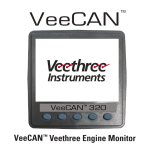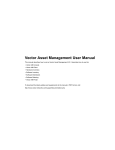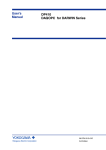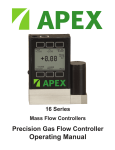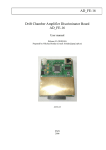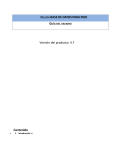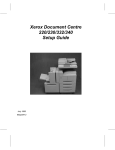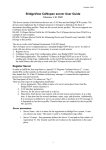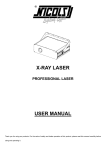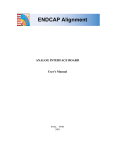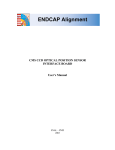Download Gas System Software Manual
Transcript
Gas System Software Manual By Peter Kravtsov (E-mail: [email protected]) This document location: http://lkst.pnpi.nw.ru/pdf/cbm_rich_gas_soft.pdf February 2011 Gas system software manual Introduction The software described in this document was developed for the slow control of the gas systems in STAR and PHENIX detectors and after some modifications is used to control CBM RICH gas system. The software provides manual control of the gas system and data acquisition for all sensors, shows measured system parameters and maintains the gas system database. Besides, the software reacts on some gas system faults and takes care for automatic recovering. The gas system software works in Windows 2000 or Windows XP. The software consists of three separate programs. Gas system control program does most of the job and controls the gas system. DBViewer [1] provides visualization of the data for any gas system process variable and export data from the database to MS Excel or tab-delimited text file for further analysis. Charts [2] program displays up to ten selected system parameters in the time chart format. Besides, it could be used for tabular display of the process variables, with extra alarm signals for every parameter in the table. In addition, the TCP/IP client/server is implemented in the Charts software so that it can be used remotely for monitoring the system under control. The software utilizes MS Access database engine to keep the history of all system parameters and event messages. DBViewer and Charts programs are documented separately. Page 2 of 12 Gas system software manual Gas system control program The main control process contains two threads. The first one provides graphical user interface (GUI) and events log, while the second thread does data acquisition, device control and alarms handling. The priority of the second thread is set to highest value for reliable work in crowded system. The main window contains several tabs: 1. Main control provides basic gas system control. 2. System parameters tab is used for control electronics specific parameters like communication properties, reading interval. 3. Alarms tab contains alarm handlers list. 4. Database tab is used for the database control and also for changing the sensor coefficients. 5. DAQ32 tab can be used for fine tuning the DAQ32 module and is not necessary for gas system operation. Main control The Main control tab of the gas system software gives user a possibility to control gas system manually (Fig. 1). It has simplified gas scheme in the main window [3]. The buttons on the gas scheme represent every solenoid valve and device controlled by software. Red button state means either closed valve or switched off device, while green one stays for open valve or switched on device. Note that some solenoid valves and devices are controlled by the pressure switch PIS1 and therefore may be blocked for software control. Page 3 of 12 Gas system software manual Fig. 1. Main control of the gas system. All the sensors being read by the software are displayed at right side of the window. There is a possibility to see sensor’s voltages, which can be useful for coefficients calculation. Additional controls beneath the sensors list are used to enable or disable alarms and to control the gas system operation parameters. Note that all alarms are disabled by default at program start. All gas system parameters are logged into the database with specified time interval. Current database name is always shown in the window caption. Each software event is logged into the event log at the bottom of the main window and into the current database as well. In case of alarm trigger the alarm message is also logged and corresponding sensor is displayed in red color in the list. Page 4 of 12 Gas system software manual Pressure regulation controls are used to control the pressure inside the detector or fresh gas flow. [Enable PT4 regulation] checkbox switches the PID control algorithm in the slow control module which stabilizes detector pressure at specified setpoint. [Set] button sends pressure regulation parameters to slow control module. If [Enable PT4 regulation] checkbox is cleared, operator can control FM1 flow controller directly. Three mode buttons are used to control the basic gas system procedures. [Purging Mode] button starts and stops the purging procedure. Before starting the purging, operator should specify the desired pressure in the detector and total purging gas volume (10 litres in Fig. 1). Then, by starting the purging mode, the software will open all necessary valves and smoothly increase the flow to minimize pressure overshoot. Then it calculates the gas volume passed through the FM1 controller and shows it along with the estimated finish time for purging (Fig. 1). By purging 90% of required gas volume the software opens SV3 and purge analyzers also to remove traces of oxygen and water if necessary. When the necessary volume passed through the detector, the software displays the message about finishing the purging and keeps the system in purging mode as the safest configuration. [Start Normal] button serves to begin the normal gas system operation with recirculation of the gas. The procedure is as follows (Fig. 2). The software starts gas circulation by switching on the compressor with closing the valves SV1, SV3, SV4, SV7, and opening the valves SV2, SV5, SV6. This configuration connects analyzers to purifier and dryer output. Then, after one minute, the software checks the oxygen and moisture content. If one of them does not fall below 100ppm, they will be checked during 5 minutes in total and in case of high impurity concentration the software logs the corresponding message and keeps the system in this configuration. After successful checking the purification units SV5 valve is closed and SV4 valve is opened to establish the normal circulation gas flow through the purification units and to connect analyzers to compressor Page 5 of 12 Gas system software manual output. Then FM1 flow is checked after one minute. If it falls below 0.2slpm, the software logs alarm message. BPCV1 should be slightly adjusted in this case to increase the exhaust flow, which in turn will increase the fresh gas flow to detector. Fig. 2 shows the normal operation starting without any fail. Fig. 2. Start normal operation messages. [Stop circulation] button stops compressor and switch the gas system to simple purge mode through the FM1. System parameters System parameters tab (Fig. 3) contains communication parameters for the slow control electronics and fine tuning parameters for the system regulation loops. Communication parameters are adjusted during assembling of the system and most of them should be kept untouched during gas system operation. The [Connect] button is used to connect to slow control module at the selected com port. It could also be used to reconnect the device if it was switched off. The device is connected automatically during program startup. The most important parameters here are Data poll interval and Database interval. The first one defines the time period between data reading from the slow control electronics. Database interval defines the time period of the data saved to the database. It is recommended to set Database interval to at least 20 seconds, since the gas system processes are slow enough. In case of alarm the data saved to the database immediately out of turn. [Ask valves control confirmation] checkbox prevents accidental clicking on the valves in the main control tab. A confirmation will be requested by every valve switching if this checkbox is checked. Page 6 of 12 Gas system software manual Fig. 3. System parameters tab. PT4 control group allows fine tuning of the PID regulation loop for detector pressure. Setpoint [SP] repeats the setpoint from main control tab. [t_max] value defines time constant of the PID algorithm in seconds. [COmax] is the limit for controller output with maximum value of 65535. [K_P], [K_D], [K_I] are the proportional, differential and integral coefficients of the PID algorithm, correspondingly. It is not recommended to change these parameters during normal system operation. [Update] buttons reads these parameters from slow control module; [Set] button sends changed parameters back to the device. Alarms The Alarms configuration tabsheet (Fig. 4) is designed to display and change alarms levels and actions to be taken in case of any particular alarm. The following parameters are available for every alarm: • Alarm name with enable checkbox, which allows enable or disable each particular alarm • Active sensor for this alarm • Alarm level (sensor value exceeding level causes alarm) • Alarm recovery level (sensor value below this level recovers system from alarm, once it has been triggered) Page 7 of 12 Gas system software manual • Threshold sign (sensor value comparison sign) • Count (number of exceeding sensor readings for alarm) • Alarm message, which will be logged in case of alarm • Alarm message color • Valves pattern that will be applied in case of alarm Fig. 4. Alarms configuration. Alarms handling algorithm is very similar to that implemented in the hardware Alarm System, which was developed for STAR and PHENIX experiments (see Alarm System Manual [2] for details). After each measuring cycle, DAQ thread compares alarm thresholds for all enabled alarms with appropriate sensor values using alarm comparison signs. If the sensor value exceeds the alarm level, it displays alarm message and updates valves according to the alarm valves configuration (red valves will be closed, green will be open, while gray will be left intact), storing the list of affected valves in memory. Upon alarm recovery event, i.e. if the sensor value returns to alarm return level, the code Page 8 of 12 Gas system software manual changes only those valves, which were not alarmed by the other sensors, making use of the stored list of the changed outputs. Note that instead of special default state used in Alarm System, PC software uses current valves state at every alarms checking cycle. This means that no valves and devices are affected if nothing happens with alarm situation, i.e. neither alarms nor alarm returns happened. The alarms configuration is stored in special ini file. There are two copies of alarms setup: normal and default. Normal setup is used each time the program starts, while defaults intended to be used as a reference. The buttons at the window’s bottom allows performing the following service tasks: – Save alarms configuration to binary file – Load alarms configuration from binary file – Export alarms configuration to tab-delimited text file – Export alarms configuration to MS Excel file – Save alarms configuration to registry as defaults – Add new alarm to bottom of alarms list – Copy current alarm to a new one at the bottom of the list – Move current alarm up (just for aesthetic purposes) – Move current alarm down (just for aesthetic purposes) – Delete selected alarm from the list Database The Database tab contains the database parameters and also the sensor coefficients (Fig. 5). All gas system parameters (channels) are divided into three groups (Fast, Slow and Control). Only Fast and Control groups are used for the gas system. Page 9 of 12 Gas system software manual Fig. 5. Database configuration. First 32 Fast channels correspond to 32 sensors of the slow control module. Channels 33-36 correspond to four analog outputs of the slow control module. Sensor value for these channels is calculated from the voltage using the following formula: S = (V + KA) ⋅ KB . Every channel has the following editable properties: • name, • value coefficients KA and KB, • averaging coefficient AVG, • sensor units, • branch, • comment. Name, units and comment are simple strings that used to identify system parameter in visualization software. Averaging coefficient (AVG) is used to average the sensor values. Running average is calculated by the formula: Si = AVG ⋅ S i + (1 − AVG ) ⋅ S i −1 . Thus, AVG=1 means no averaging, AVG=0.1 is equal to averaging by 10 samples. Page 10 of 12 Gas system software manual The channel branches are used for data channel grouping in Charts and DBViewer programs. For the systems with 100 or more parameters it becomes very useful to group these parameters by subsystem. In this particular case only two groups are used: GAS branch contains all gas system parameters, while all slow control module specific parameters belong to Device branch (like PID coefficients, device reading time etc.). There is also special Disabled branch for unused parameters. Usually it is not displayed in Charts and DBViewer programs. Using small toolbar in top-right corner of the window operator can read and save channel configuration to ini file. Usually it is saved automatically at the program shutdown, if checkbox [Save channels config on exit] is checked. This ini file is also used for the Charts program to display the list of the available parameters. Channel configuration can also be saved or read from the current database. Database control toolbar provides two actions for changing the active database: create a new database and open existing database. In addition, the software has special limit for the database file size (set to 800Mb in Fig. 5). By reaching this limit it starts new database automatically with the date and time in the name and writes an appropriate message in the main log. Page 11 of 12 Gas system software manual References 1. DBViewer Manual: http://lkst.pnpi.nw.ru/pdf/DBViewer2en.pdf 2. Charts User Manual: http://lkst.pnpi.nw.ru/pdf/chartsen.pdf 3. See gas system scheme. 4. Alarm System Manual: http://lkst.pnpi.nw.ru/pdf/alarm_manual.pdf Page 12 of 12















